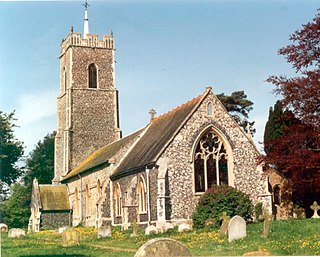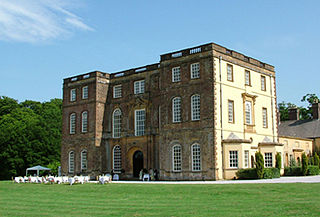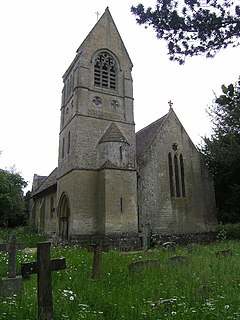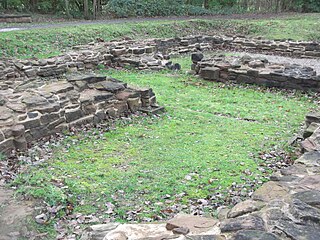Sources
- Victor Skipp (1980). A History of Greater Birmingham – down to 1830. Victor Skipp. ISBN 0-9506998-0-2.
- British History Online: A History of the County of Worcester: volume 3 - Parishes: Yardley
Greet (grid reference SP100841 ) is a historical area in south Birmingham, England, around modern Sparkhill.
Now a name obsolete in addresses, Greet, meaning "gravel" (grit)", was one of the medieval manors around Birmingham on the eastern gravelly slopes of the sandstone ridge which runs through central Birmingham. The manor was a timber-framed house, first mentioned in 1562, with the majority of the surrounding land being owned by Studley Priory. This land had been given to the priory by William de Edricheston in 1254, soon after he had acquired it. The land remained in the ownership of the Priory until 1545 when it was sold to Clement Throckmorton and Sir Alexander Avenon, an ironmonger who would later become Lord Mayor of London. Avenon gave the land to his son and wife in 1570, before dying in 1580. In 1586, his son, Alexander, pledged his manor to cover a debt which he owed to a Thomas Starkey, and in the same year sold the reversion to James Banks, who sold it in 1601 to Henry Greswolde. Greswolde died in 1602 and left Greet to his eldest son, George, who was just thirteen years old at the time. Dorothy, widow of Henry, continued to live at Greet manor, having purchased from Joan, widow of Thomas Starkey, her interest in the manor.
George Greswolde died in 1612, and was succeeded by his brother Humphrey. He died in 1660, and was succeeded in turn by his two sons Humphrey, who died in 1671, and Henry, who died in 1700, leaving four sons. These were: Humphrey who died unmarried in 1712, Henry who left a daughter Anne, Marshal and John. In 1776, Henry Greswolde Lewis, held a third. The other two thirds were held, in 1784, by William Richard Wilson and Jane Anne Eleanor, his wife, who appear to have given up their share to Henry Greswolde Lewis. He was succeeded in 1829 by his kinsman, Edmund Meysey Wigley, who assumed the name Greswolde and died unmarried in 1833. On his death, Henry Wigley, who also assumed the name Greswolde, became tenant for life under the will of Henry Greswolde Lewis, and he and his son, Edmund Greswolde, who was tenant in line, barred the estate in tail and conveyed the estates to the use of Henry Greswolde for life, with remainder to Edmund Greswolde in fee simple. Edmund died in 1836, and on his death, his father succeeded to the estates in fee simple under the will of Edmund.
Situated next to Wake Green, Greet gave its name to Greet Common (upon which now stands Moseley School), and the now lost Greet Mill (grid reference SP099827 ), at the point where the A34 road crosses the River Cole between Sparkhill and Hall Green. Greet Mill was the water mill 1 km. north (downstream) of Sarehole Mill and was first mentioned in 1275. Another mill was also located in Greet, called Lower Greet Mill, which was first mentioned in 1725.

Ickleton is a village and civil parish about 9 miles (14 km) south of Cambridge in Cambridgeshire, England. The village is beside the River Cam, close to where a southern branch of the Icknield Way crossed the river. The eastern and southern boundaries of the parish form part of the county boundary with Essex, and the Essex town of Saffron Walden is only about 4.5 miles (7 km) southeast of the village.

Anne of Gloucester, Countess of Stafford was the eldest daughter and eventually sole heiress of Thomas of Woodstock, 1st Duke of Gloucester, by his wife Eleanor de Bohun, one of the two daughters and co-heiresses of Humphrey de Bohun, 7th Earl of Hereford, 6th Earl of Essex (1341–1373) of Pleshy Castle in Essex.

Campsea Ashe is a village in Suffolk, England located approximately 5 miles (8 km) north east of Woodbridge and 6 miles (10 km) south west of Saxmundham.

Prideaux Place is a grade I listed Elizabethan country house in the parish of Padstow, Cornwall, England. It has been the home of the Prideaux family for over 400 years. The house was built in 1592 by Sir Nicholas Prideaux (1550–1627), a distinguished lawyer, and was enlarged and modified by successive generations, most notably by his great-great-grandson Edmund Prideaux (1693–1745) and by the latter's grandson Rev. Charles Prideaux-Brune (1760–1833). The present building, containing 81 rooms, combines the traditional E-shape of Elizabethan architecture with the 18th-century exuberance of Horace Walpole’s Strawberry Hill Gothic.

Henry de Ferrers, magnate and administrator, was a Norman who after the 1066 Norman conquest was awarded extensive lands in England.

Pishiobury, sometimes spelled Pishobury, was a manor and estate in medieval Sawbridgeworth, Hertfordshire. Its denomination as "Pishiobury" only emerged in the mid to late 19th century.

The Barony of Halton, in Cheshire, England, comprised a succession of 15 barons and hereditary Constables of Chester under the overlordship of the Earl of Chester. It was not an English feudal barony granted by the king but a separate class of barony within the County Palatine of Chester.

Halswell House is a Grade I listed country house in Goathurst, Somerset, England.

Börringekloster Castle, formerly Börringe Priory is a castle built in 1763 on the ruins of a medieval Benedictine priory at Svedala in Scania, Sweden.
Aubrey (Albericus) de Vere was a tenant-in-chief in England of William the Conqueror in 1086, as well as a tenant of Geoffrey de Montbray, bishop of Coutances and of Count Alan, lord of Richmond. A much later source named his father as Alphonsus.
Elizabeth de Bohun, Countess of Northampton was the wife of two English noblemen, Sir Edmund Mortimer and William de Bohun, 1st Earl of Northampton. She was a co-heiress of her brother Giles de Badlesmere, 2nd Baron Badlesmere.

Little Tew is an English village and civil parish about 4+1⁄2 miles (7 km) northeast of Chipping Norton and 8+1⁄2 miles (14 km) southwest of Banbury in Oxfordshire. The parish is bounded to the northwest by the River Swere and a road between Little Tew and Hook Norton, to the north by a tributary of the River Cherwell and to the south by an ancient drovers' road called Green Lane. The remaining parts of the parish bounds are field boundaries. The 2011 Census recorded the parish's population as 253.
Edward of Salisbury was a nobleman and courtier (curialis), probably part Anglo-Saxon, who served as High Sheriff of Wiltshire during the reigns of William I, William II and Henry I.

Cottisford is a village and civil parish in Oxfordshire, about 3.5 miles (5.6 km) south of Brackley in neighbouring Northamptonshire. The parish's northern and northwestern boundaries form part of the boundary between the two counties. The parish includes the hamlet of Juniper Hill about 1 mile (1.6 km) northwest of Cottisford. The 2011 Census recorded the parish's population as 216.

Farewell Priory was a Benedictine nunnery near Lichfield in Staffordshire, England. Although it received considerable episcopal support, it was always small and poor. It was dissolved in 1527 as a by-product of Cardinal Wolsey's scheme to establish a college within Oxford University.

Sandwell Priory was a small medieval Benedictine monastery, near West Bromwich, then part of Staffordshire, England. It was founded in the late 12th century by a local landowner and was only modestly endowed. It had a fairly turbulent history and suffered considerably from mismanagement. It was dissolved in 1525 at the behest of Cardinal Wolsey – more than a decade before the main Dissolution of the Monasteries under Henry VIII.

Penkridge is a village and parish in Staffordshire with a history stretching back to the Anglo-Saxon period. A religious as well as a commercial centre, it was originally centred on the Collegiate Church of St. Michael and All Angels, a chapel royal and royal peculiar that maintained its independence until the Reformation. Mentioned in Domesday, Penkridge underwent a period of growth from the 13th century, as the Forest Law was loosened, and evolved into a patchwork of manors of greatly varying size and importance, heavily dependent on agriculture. From the 16th century it was increasingly dominated by a single landed gentry family, the Littletons, who ultimately attained the Peerage of the United Kingdom as the Barons Hatherton, and who helped modernise its agriculture and education system. The Industrial Revolution inaugurated a steady improvement in transport and communications that helped shape the modern village. In the second half of the 20th century, Penkridge grew rapidly, evolving into a mainly residential area, while retaining its commercial centre, its links with the countryside and its fine church.

Combe is a historic estate in Somerset, England, situated between the town of Dulverton and the village of Brushford.

Dolobran, in the county of Montgomeryshire in Wales, is a historic estate which was the earliest known seat of the expansive Lloyd family, prominent Quakers, of which in the 18th century a junior branch, the Lloyd family of Birmingham, seated at Farm, Bordesley, became prominent in and around Birmingham as iron-founders and founded Lloyds Bank, today one of the largest banks in the United Kingdom. The grade II* listed manor house known as Dolobran Hall about 8 miles north-west of the town of Welshpool, is situated in the parish of Meifod to the west of the village of Meifod and to the east of the village of Pontrobert. One of the family historians, Humphrey Lloyd (1975), estimated the historic estate of Dolobran to have comprised about 1,000 acres. In 2015 Dolobran Hall and its 70-acre estate are used for farming and industrial training by the J.M. Evans Partnership. John Meirion Evans (1926–2015) of Dolobran Hall by his wife Edith was father to Maurice, Keith and Robert. In 2008 former farmer Rob Evans founded a company to train construction workers in the use of plant and machinery called "Training For The Future", based at "The Brick Barn Dolobran Hall".

The feudal barony of Stafford was a feudal barony the caput of which was at Stafford Castle in Staffordshire, England. The feudal barons were subsequently created Barons Stafford (1299) by writ, Earls of Stafford (1351) and Dukes of Buckingham (1444). After the execution of the 3rd Duke in 1521, and his posthumous attainder, the castle and manor of Stafford escheated to the crown, and all the peerage titles were forfeited. However the castle and manor of Stafford were recovered ten years later in 1531 by his eldest son Henry Stafford, 1st Baron Stafford (1501-1563), who was created a baron in 1547. His descendants, much reduced in wealth and prestige, retained possession of Stafford Castle and the widow of the 4th Baron was still seated there during the Civil War when shortly after 1643 it was destroyed by Parliamentarian forces. By the time of the 6th Baron Stafford (d.1640) the family had sunken into poverty and obscurity, and in 1639 he suffered the indignity of being requested by King Charles I to surrender his title on account of his "having no parte of the inheritance of the said Lord Stafford not any other landes or means whatsoever". On his death the following year, unmarried and without issue, the senior male line of the Stafford family was extinguished. However a vestige of the feudal barony may be deemed to have continued in the families of later owners of the manor of Stafford and site of the Castle, after the abolition of feudal tenure in 1661.